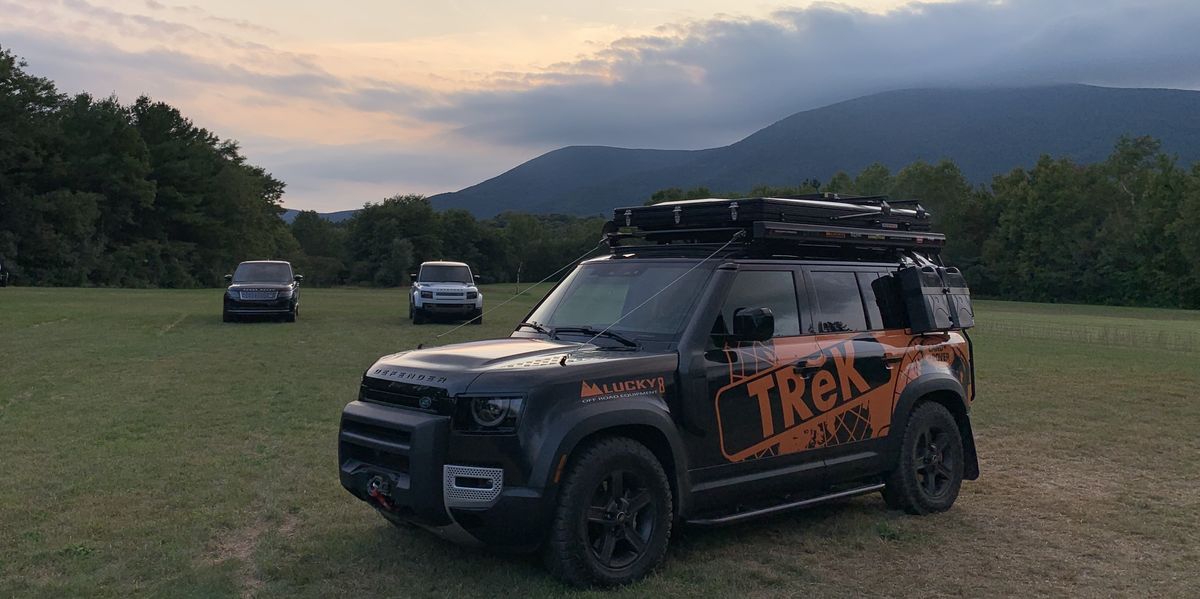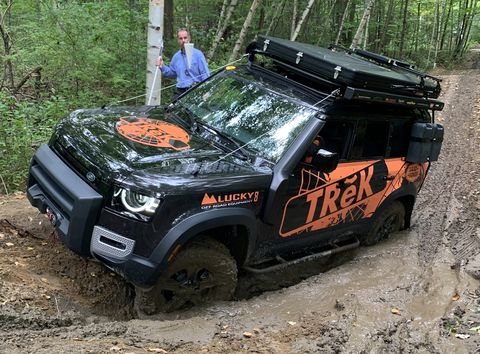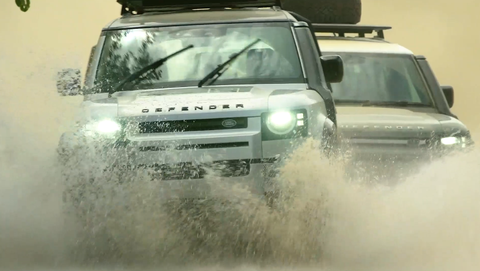Camping and Off-Roading with the Defender at the Land Rover Trek Competition

The Jeep Wrangler dominates the off-roading scene in the United States, but travel internationally and you’ll find a different nameplate that’s synonymous with conquering tough terrain: Land Rover Defender. From carrying personnel in the Carrara marble quarries of Italy to roving the lush farmland of England and traversing the harsh desert of Namibia, the Land Rover Defender has been a stalwart companion for those exploring beyond the end of the pavement since it arrived in 1983 as the One Ten. But 2020 saw the classic workhorse replaced by an all-new Defender—officially offered in the U.S. for the first time since the mid-1990s—that ditched the bare-bones, rough-edged body-on-frame approach of the original for an aluminum unibody and an upscale interior.
Combining a luxurious cabin with the promise of all-terrain abilities, the new Defender quickly became a popular choice in upper-middle-class suburban America, shuttling the kids to school and hauling groceries home from the supermarket. But a recent trip to take part in the Land Rover Trek competition served as a reminder that the Defender doesn’t just suggest off-road capability with its squared-off looks and Land Rover badge. During our time with the Trek program—a grueling two-day adventure designed to educate dealership employees—we were reacquainted with the Defender’s extreme off-road chops as it became our go-anywhere mobile home for a night.
Caleb Miller|Car and Driver
Rooftop Tents, Gear Add Utility (and Weight)
The Trek competition sees retail employees—plus a batch of journalists—driving modified 2023 Defender 110s. The most obvious change to the Trek vehicles is the Roofnest Falcon Pro rooftop tent, which costs $3995 and weighs 180 pounds. The Defenders are also fitted with a remote-controlled electronic Warn winch, a snorkel air intake, a gear carrier box affixed to the side of the cabin, and a beefier front under-shield for protecting vital mechanical components from protruding rocks. Other goodies included an ARB refrigerator in the cargo area, a solar panel perched atop the tent, two exterior-mounted water containers, and limb risers stretching from the hood to the roof to guide tree branches out of the way on narrow trails.
All this equipment strapped to the Defender severely compromises the on-road driving experience. The extra weight makes acceleration an exercise in patience, especially given that our Defenders were powered by the base turbocharged 2.0-liter inline-four. The 296 horsepower produced by that engine is enough for daily driving in an unmodified 110, but with the increased weight, we wished we had the 395-hp inline-six or even the 518-hp supercharged V-8.
The added heft also meant that the brakes needed to work that much harder to bring the rig to a stop. The rooftop tent and other exterior-mounted equipment also noticeably raised the center of gravity, requiring us to use caution when navigating the twisty two-lane highways of upstate New York and Vermont. Plus, at speeds above 50 mph the tent and other protrusions amplified wind noise to a deafening howl.

Caleb Miller|Car and Driver
Over the Rocks
But the heavier load didn’t seem to affect the Defender much when tackling the off-road challenges set out by Land Rover on its property in Manchester, Vermont. On a series of all-terrain courses, the Defender confidently scaled mud-covered hills and adeptly trundled over large rocks. The experience inside was surprisingly serene and relaxing, with the standard air springs absorbing bumps and keeping the cabin fairly level over the undulating topography. Even with the Warn winch attached to the front bumper, the 110 had excellent approach and departure angles, allowing for impressive agility in tight spaces and on steeply inclined hills. We never scraped the front skid plate or high-sided the SUV, with the Defender seemingly egging us on to find it more demanding challenges.
Unlike the original Defender, the new 110 uses technology to help it tackle tricky off-road trails. The start of one of the courses featured an approximately 45-degree drop down a rocky slope, but the vehicle’s hill-descent control easily managed our speed, leaving us to focus on avoiding the largest obstacles in our path. The height-adjustable air suspension also came in handy during an accuracy challenge, where we were tasked with steering our Defender to hit hanging cones with a target stuck onto our roof. The height-adjustable air suspension allowed us to raise or lower the vehicle in order to line up the right trajectory to hit a cone with the target. The backup camera, along with a suite of other camera views, also played a critical role in the Defender’s finesse in the tight and twisty route through the forest.

Caleb Miller|Car and Driver
Despite the compromises on the highway, we were thankful for all of the gear our Defender was carrying when we stopped for the night. The fridge provided us with cool water after a long and tiring day and also preserved the ingredients for our dinner cookout. Setting up our rooftop tent was a breeze, with the hydraulic folding mechanism slowly opening the tent after a light upward push. Once erected, the tent was comfortable—with a soft floor and plenty of room for one person—and warm, allowing us to avoid the cold ground as temperatures dropped into the low 50s at night.
When we got back on the New York State Thruway to return to Jaguar Land Rover headquarters in Mahwah, New Jersey, we were quickly reminded of the tradeoffs that came with transporting several hundreds of pounds of equipment on the roof. But the Defender’s all-terrain competence and our cozy night in the tent had won us over. We stopped worrying about the sluggish acceleration and ungainly handling, instead slowing down to appreciate the picturesque New York countryside as the leaves began to don their autumnal hues.

This content is imported from OpenWeb. You may be able to find the same content in another format, or you may be able to find more information, at their web site.



